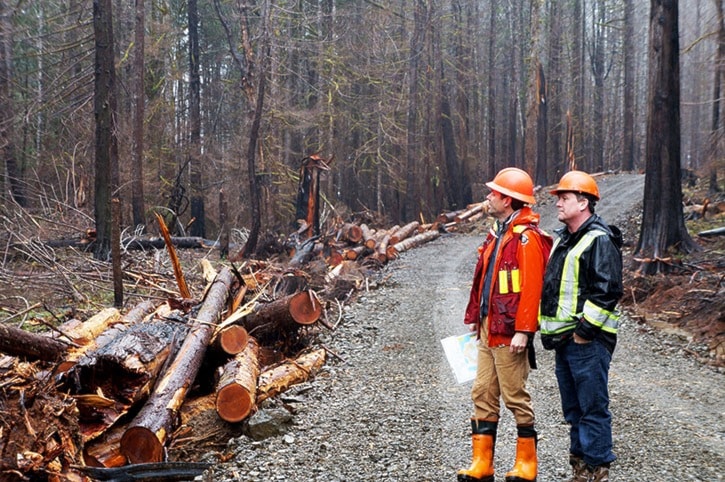The Hupacasath First Nation is hoping to make Dog Mountain green again after a forest fire in the summer of 2015 razed much of the mountain.
The Hupacasath has been approved for salvage operations on the fire-damaged land.
Dog Mountain on Sproat Lake was struck by fire in early July 2015 that consumed about 425 hectares of the landscape, affecting almost 100 per cent of the peninsula. The fire was mainly ground based and consumed almost all of the existing understory vegetation, woody debris and organic soil layers, leaving exposed mineral soils and scorched tree stems throughout much of the area.
The Hupacasath is undergoing an operation to salvage damaged timber from the mountain and engage in further restoration work. Both the Hupacasath and Tseshaht First Nation have strong cultural connection to the area.
Hupacasath Chief Councillor Steven Tatoosh said during a tour of Dog Mountain before Christmas that the salvage operation was derived from an accommodation agreement the Hupacasath had been negotiating with the Crown prior to the fire.
“There were 15,000 cubic metres for salvage opportunities for us,” Tatoosh said. “After the Dog Mountain fire we thought it was devastating but it was also an opportunity for going there and cleaning up.”
The First Nations are working with a local contractor, Probyn Logging, who are marketing the salvaged logs to mills on Vancouver Island.
Several areas of salvage opportunity were identified at the west end of Dog Mountain and have been narrowed down to three blocks—approximately 20 hectares—which will require 1.2 km of new road.
Warren Lauder, forest resource manager with the Hupacasath, said in the spring reforestation will begin to make Dog Mountain green again.
“We have a salvage license to harvest damaged and down timber and that came out of an accommodation agreement with the government,” Lauder said. “We’ve applied that license to Dog Mountain for the burnt timber and I guess there’s a small economic opportunity for us, but the biggest thing is this spring we’re going to start the reforestation end of it so we’re going to invite our neighbouring nations and all user groups [to help].”
The damaged timber consists of Douglas fir, western red cedar and western hemlock. Any healthy trees in the area will be retained.
The salvage will take place under Forestry License to Cut A93153 in association with the BCTS West Coast Forest Stewardship Plan (FSP) that specifies results and strategies that apply to the area.
“This spring with the reforestation we want everybody that wants to be a part of it to come out and contribute in some form or fashion,” Lauder said. “We’ve already got the prescriptions laid out for cedar and fir and a mixture of trees to go in there.”
Len Apedaile, forester with Econ Consulting has worked with Hupacasath since 2000, when the nation received its first forest tenure; Woodlot 1902 in Port Alberni. Since then, they’ve added Woodlot 1476 at Sproat Lake and a First Nations Woodland License at Great Central Lake.
“One of the other tenure initiatives that [Hupacasath] got through negotiations with the government is a salvage license to cut which is essentially a 10-year license to harvest dead and damaged timber within the Sproat landscape,” Apedaile said. “This tenure was just issued and made available last year. We identified this opportunity to try to get involved and do something on Dog Mountain. That discussion started very soon after the fire.”
On the hillside of Dog Mountain, many of the trees damaged in the fire are burnt from ground level to about five or six metres up the trunk.
Apedaile said the Dog Mountain fire was a ground-level fire and that there’s very little of the wood under the bark that is actually burnt or affected by the fire.
“That’s an important part of the salvageability,” Apedaile said. “The fire when it passed through on the ground burnt up along the outside of the trees but very few of the actual crowns of the trees were involved in the fire.”
Harvesting for the timber began in the fall before further deterioration of the wood quality and value occurred. The fir and hemlock experienced attack by Ambrosia beetle in the summer.
“With the timing of the fire in July 2015, there wasn’t a lot of Ambrosia attack that season because the Ambrosia season would have been earlier...but we really noticed it this year in late June and July,” Apedaile said.
Ambrosia beetles only attack “white woods,” Apedaile said, like Douglas fir and hemlock. Cedar is not impacted by insects.
Anyone wanting more information about the Dog Mountain salvage project can contact the Hupacasath First Nation at 250-724-4041.
karly.blats@albernivalleynews.com
facebook.com/albernivalleynews
